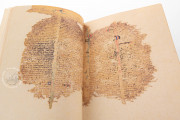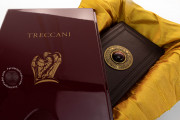The Bible of Marco Polo is the only known extant manuscript among those taken to China by Europeans between the thirteenth and fourteenth centuries. The volume is an example of a "pocket Bible," a small sacred text for personal use, which symbolically served as an "ambassador" between Europe and China for many centuries. The Bible of Marco Polo is both a relic of Western populations' travels to China and a symbol of the Christian influence in China after the thirteenth century.
Minute Script and Luxury Parchment
Each chapter contains a large initial in red or blue ink, watermarked in red, blue, or green. The widely abbreviated text is a form of textualis formata, a script that reminds one of the warp-weft patterns of fabric (from the Latin form textilis, meaning "woven"). The text was produced by a single hand with one single type of ink, and at least three hands added marginal notes with three different kinds of ink, one of which is red.
Due to its small dimensions and tiny corpus size (below 2 mm), the Bible was presumably destined for private use. Its original version, now partially damaged, contained the Old and New Testaments. The first folio, usually the most richly illuminated, is missing. Its watermarked initials are reminiscent of southern French manuscripts from the 1240s, while the overall style points to bibles made in Paris in the 1230s.
The small-size folios are made of ultra-thin, high-quality parchment sourced from newborn or stillborn animals, called vélin (uterine vellum) in French. The parchment is extremely thin, almost transparent, as soft and smooth as silk, and as pale as human skin.
A Bible's Travels around the World
In a signed note preserved together with the codex, the Jesuit father Philippe Couplet stated he found the volume in the Chinese city of Changshu in the home of a pagan who claimed his family had owned it since the Yuan Dynasty (1271-1368), when the Venetian explorer Marco Polo set foot in the East. The manuscript has been preserved in the Laurentian Library in Florence presumably since 1752, the date the item was first recorded. Between 2008 and 2010 the Bible was exhibited to the public for the first time.
We have 1 facsimile edition of the manuscript "Bible of Marco Polo": Bibbia di Marco Polo facsimile edition, published by Istituto dell'Enciclopedia Italiana - Treccani, 2012
Request Info / Price




















